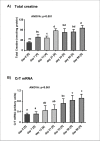Changes in creatine transporter function during cardiac maturation in the rat
- PMID: 20569423
- PMCID: PMC2909979
- DOI: 10.1186/1471-213X-10-70
Changes in creatine transporter function during cardiac maturation in the rat
Abstract
Background: It is well established that the immature myocardium preferentially utilises non-oxidative energy-generating pathways. It exhibits low energy-transfer capacity via the creatine kinase (CK) shuttle, reflected in phosphocreatine (PCr), total creatine and CK levels that are much lower than those of adult myocardium. The mechanisms leading to gradually increasing energy transfer capacity during maturation are poorly understood. Creatine is not synthesised in the heart, but taken up exclusively by the action of the creatine transporter protein (CrT). To determine whether this transporter is ontogenically regulated, the present study serially examined CrT gene expression pattern, together with creatine uptake kinetics and resulting myocardial creatine levels, in rats over the first 80 days of age.
Results: Rats were studied during the late prenatal period (-2 days before birth) and 7, 13, 21, 33, 50 and 80 days after birth. Activity of cardiac citrate synthase, creatine kinase and its isoenzymes as well as lactate dehydrogenase (LDH) and its isoenzymes demonstrated the well-described shift from anaerobic towards aerobic metabolism. mRNA levels of CrT in the foetal rat hearts, as determined by real-time PCR, were about 30% of the mRNA levels in the adult rat heart and gradually increased during development. Creatine uptake in isolated perfused rat hearts increased significantly from 3.0 nmol/min/gww at 13 days old to 4.9 nmol/min/gww in 80 day old rats. Accordingly, total creatine content in hearts, measured by HPLC, increased steadily during maturation (30 nmol/mg protein (-2 days) vs 87 nmol/mg protein (80 days)), and correlated closely with CrT gene expression.
Conclusions: The maturation-dependant alterations of CK and LDH isoenzyme activities and of mitochondrial oxidative capacity were paralleled by a progressive increase of CrT expression, creatine uptake kinetics and creatine content in the heart.
Figures




Similar articles
-
Long-term beta-blocker treatment prevents chronic creatine kinase and lactate dehydrogenase system changes in rat hearts after myocardial infarction.J Am Coll Cardiol. 1996 Feb;27(2):487-93. doi: 10.1016/0735-1097(95)00458-0. J Am Coll Cardiol. 1996. PMID: 8557926
-
Regional biochemical remodeling in non-infarcted tissue of rat heart post-myocardial infarction.J Mol Cell Cardiol. 1996 Jul;28(7):1531-8. doi: 10.1006/jmcc.1996.0143. J Mol Cell Cardiol. 1996. PMID: 8841940
-
Creatine transporter activity and content in the rat heart supplemented by and depleted of creatine.Am J Physiol Endocrinol Metab. 2003 Feb;284(2):E399-406. doi: 10.1152/ajpendo.00259.2002. Am J Physiol Endocrinol Metab. 2003. PMID: 12531746
-
Compartmentation of creatine kinases during perinatal development of mammalian heart.Mol Cell Biochem. 1994 Apr-May;133-134:277-86. doi: 10.1007/BF01267960. Mol Cell Biochem. 1994. PMID: 7808459 Review.
-
Role of creatine kinase isoenzymes on muscular and cardiorespiratory endurance: genetic and molecular evidence.Sports Med. 2001;31(13):919-34. doi: 10.2165/00007256-200131130-00003. Sports Med. 2001. PMID: 11708401 Review.
Cited by
-
Normal cardiac function in mice with supraphysiological cardiac creatine levels.Am J Physiol Heart Circ Physiol. 2014 Feb;306(3):H373-81. doi: 10.1152/ajpheart.00411.2013. Epub 2013 Nov 22. Am J Physiol Heart Circ Physiol. 2014. PMID: 24271489 Free PMC article.
-
Role of Creatine in the Heart: Health and Disease.Nutrients. 2021 Apr 7;13(4):1215. doi: 10.3390/nu13041215. Nutrients. 2021. PMID: 33917009 Free PMC article. Review.
-
Intrauterine growth restriction impairs right ventricular response to hypoxia in adult male rats.Pediatr Res. 2016 Oct;80(4):547-53. doi: 10.1038/pr.2016.124. Epub 2016 Jun 3. Pediatr Res. 2016. PMID: 27557421
-
Perfusate Biomarkers of DCD Cardiac Graft Quality Identified With Proteomics: Studies in an Isolated Rat Heart Model.Transplantation. 2025 Apr 1;109(4):646-657. doi: 10.1097/TP.0000000000005241. Epub 2025 Mar 19. Transplantation. 2025. PMID: 39477820 Free PMC article.
-
Synergistic effect on cardiac energetics by targeting the creatine kinase system: in vivo application of high-resolution 31P-CMRS in the mouse.J Cardiovasc Magn Reson. 2023 Feb 6;25(1):6. doi: 10.1186/s12968-023-00911-6. J Cardiovasc Magn Reson. 2023. PMID: 36740688 Free PMC article.
References
-
- Rolph TP, Jones CT. Metabolism during fetal life: a functional assessment of metabolic development. Physiol Rev. 1985;65:357–430. - PubMed
-
- Taegtmeyer H. In: Myocardial energy metabolism. de Jong JW, editor. Boston: Martinus Nijhoff; 1988. Principles of fuel metabolism in heart muscle; pp. 17–34.
-
- Opie LH. Substrate and energy metabolism of the heart. Boston, Dordrecht, Lancaster: Kluver Academic Publishers; 1989.
-
- Goodwin CW, Mela L, Deutsch C, Forster RE, Miller LD, Delivoria-Papadopoulous M. Development and adaptation of heart mitochondria respiratory chain function in fetus and newborn. Exp Med Biol. 1976;75:719–719. - PubMed
Publication types
MeSH terms
Substances
Grants and funding
LinkOut - more resources
Full Text Sources
Other Literature Sources
Research Materials

